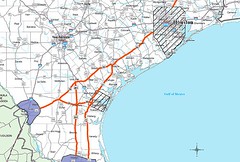"Nothing has changed. The Commission and TxDOT are hell bent to sign deals and give away the farm before the legislature can rein them in. "
6/20/08
David Stall
CorridorWatch.org
Copyright 2008
The Texas Transportation Commission never fails to amaze us.
Bottom line - this leopard has not changed its spots. Nothing has changed. The Commission and TxDOT are hell bent to sign deals and give away the farm before the legislature can rein them in. Rain, sleet and snow won't stop the mail; and, moratoriums, legislative intent and a sunset review won't stop TxDOT.
Just a week ago TxDOT tried to impress everyone with how responsive they could be as they announced their recommendation that TTC-69 focus on using existing facilities rather than building a new highway. The only thing that changes is where the TTC is built.
That action was a slap in the face to tens of thousands of Texans who are still in the path of TTC-35, which is still marching forward at full speed. Apparently they don't rate the same consideration as the Texans in east Texas.
Today we have discovered that TxDOT is about to slap the entire Legislature across the face. Remember the moratorium?
Last year Senate Bill 792 added section 223.210 to the Texas Transportation Code and put a moratorium on certain terms placed in Comprehensive Development Agreements (CDAs) of toll projects. The key limitation is that a CDA may not contain a provision permitting a private participant to operate a toll project.
The Texas Transportation Commission will meet in Austin next Thursday, June 26, 2008. Item 6a on page three of their agenda reads: "Act on the recommendation of department staff concerning: (1) the selection of the best value proposal for the planning, development, acquisition, design, construction, financing, maintenance, and operation of the element of the Trans-Texas Corridor System from Northeast Texas to the Texas/Mexico border (I-69/TTC); and (2) the execution of a comprehensive development agreement for I-69/TTC"
That's right, selecting a proposal for among other things the operation of TTC-69 and execution of a CDA. Wouldn't that be a CDA permitting the private participant to operate a toll project?
We have little doubt that TxDOT legal staff has spent plenty of hours carefully preparing a loophole that they think they can stretch wide enough to get their TTC CDA past the law. But even if they can, was the legislative intent so dim that they couldn't see that our law makers wanted them to wait another 12 months?
We can't wait to see this loophole. Will TxDOT pretend that TTC-69 isn't necessarily a toll project? No they couldn't be that stupid could they? Could they? Maybe they'll strip the offending "operation" element out of the proposal. Can they do that after the competitive proposal solicitations was issued?
Last week TxDOT told us that they were listening to the people wanting to work with their Congressional delegation and the Texas Legislature; this week their pants are on fire!
UPDATES TO THIS BREAKING STORY ARE BEING POSTED TO THE CORRIDORWATCH.ORG WEBSITE.
© 2008, CorridorWatch: www.corridorwatch.org
To search TTC News Archives click
To view the Trans-Texas Corridor Blog click








